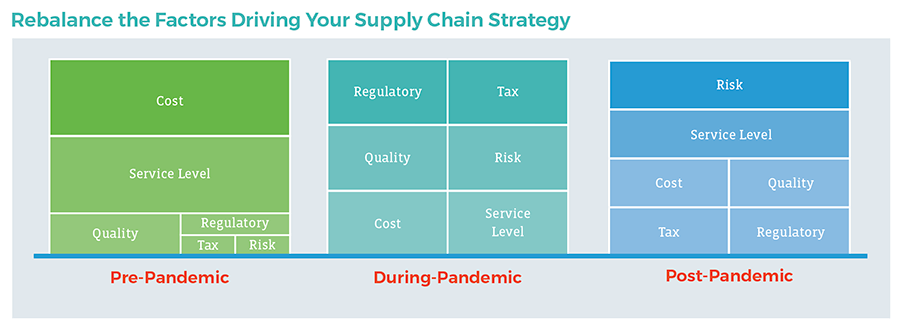4 Ways to Turn Surviving into Thriving
Your organisation has survived the worst two years the global supply chain has experienced in more than a generation. It is now clear that heightened volatility and risk are not temporary, but rather, here to stay. That doesn’t mean your organisation has to operate in a reactionary, fire-fighting mode forever. But it does mean that it’s time to look at current sourcing strategies through a more strategic lens.
Take the time to consider the changes you have been forced to make—and made quickly—to keep your lines running. Evaluate how these changes fit into a more permanent, sustainable risk mitigating sourcing model. And think through what additional layers of resiliency and flexibility you need to add.
These four tips can help you make the switch from a reactive to a proactive sourcing strategy that can future-proof your business.
1. Give even more weight to risk mitigation.
Back when the pandemic first began, supply chain managers found themselves seriously considering global supply chain risk for the first time in nearly 30 years. They rebalanced the factors driving supply chain strategy, and risk and regulatory concerns became equal to cost, quality, and service level considerations.
Fast forward 24 months and risk has become an even bigger part of the equation. Supply chain shortages and rising inflation mean pursuing a low-cost strategy is nearly impossible today. Stockpiling inventory to mitigate risk isn’t a viable option either, as this is becoming increasingly difficult and expensive to do. And manufactures must now factor in the opportunity cost of lost sales. They must think first and foremost about following a sourcing strategy that will ensure access to materials today and in an uncertain future.
Figure 1:

2. Stop thinking about alternatives as a short-term fix.
In response to unpresented raw material and component shortages, nearly every manufacturer has been forced to “make do” with alternative materials, processes, and even product designs. In our quarterly Operations Executive Roundtable discussions, participants have shared successful strategies including hiring engineers to expedite design and configuration changes, switching from injection-moulded to thermoform-moulded parts, and using pricing and lead-time incentives to nudge customers toward the most viable options.
While all of this has been done out of necessity, in some cases, the changes have led to lower costs, greater efficiencies, and even improved products. More importantly, sourcing alternatives has created a new layer of supply chain resiliency and flexibility, opening up the door to new options, as well as more potential suppliers to fulfil those options.
It is worth protectively considering what other alternatives could work in your business, even for those that items that are not a shortage crisis. Yet. For example, could K50 steel be used instead of K60? Could cold-rolled be used instead of hot-rolled? The more viable options you can identify, and the more choices you can create for your business, the better positioned you will be to respond to future crises and control your supply chain costs.
3. Take dual sourcing to the next level.
Some go-to suppliers went out of business. Others began prioritising larger customers. Some simply could not deliver. Whatever the reason, manufacturers have found alternate suppliers out of necessity. And through the process, they have become painfully aware of the vulnerabilities that a single-sourcing strategy imposes.
Now is the time to proactively address these gaps, not only for critical materials needed right now, but for all the key direct materials you source.
If you haven’t already, consider hiring some temporary assistance to help source secondary and tertiary suppliers. As you do this, be sure to think both globally and regionally. Even if you are already near-shoring or onshoring to safeguard against problems with overseas suppliers, you still need backup close to home. As the recent Ambassador Bridge incident in Canada demonstrated, even a supplier in your own backyard can run into unforeseen challenges. Make sure you have options.
4. Strengthen your position with your suppliers.
The downside of dual sourcing is less volume for each individual supplier. Splitting up your orders could potentially cause you to lose clout and preference. So, it is important to consider other ways you can gain a gain a favourable position and have a bigger influence.
Finding suppliers that are smaller or that are not currently serving the biggest players in the industry is one option. Being a more collaborative and flexible partner is another. Make the effort to understand your suppliers’ challenges and be a better customer. For example, you can give your suppliers some much needed relief in the short-term while laying the foundation for a longer-term relationship by spreading out larger orders over time.
Some manufactures go even further. We helped one major footwear and apparel company create and implement a multi-year global lean supplier assessment and development programme for 23 key suppliers. By investing directly in its suppliers’ improvement and growth, the company improved its own on-time delivery by more than 10%, nearly doubled inventory turns, and cut lead times from 102 to 60 days.
There’s no going back.
Supply chain risk is not going to dissipate anytime soon. Even if shortages on some materials improve, it is impossible to predict when or where the next global shortage will occur. Leverage lessons learnt over the past 24 months and turn them into a strategic, long-term sourcing strategy that prioritises risk mitigation. When you do, your organisation will be better prepared for whatever happens in the world next.





